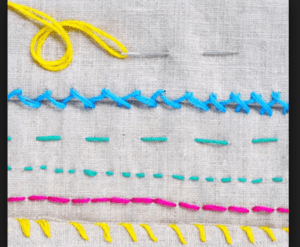Sewing And Stitches: People that sew clothes will quickly remind you that they are fashion designers when you try to call them tailors. This trendy name seems to be a perfect fit seeing how they recreate fashion in the most amazing way.
Many have abandoned their educational qualifications to take up this lucrative profession. If you’re new to tailoring, you may be having a hard time trying to understand different types of stitches and where to apply them. Stitches come in various styles; some are handmade while some are made with sewing machines.
As a beginner, you should start with hand stitches, all you is a needle, thread, and fabric. Hand stitches have been grouped into six categories for easy understanding:
1) Running Stitch
This is the first stitch you will learn and use as a beginner. Your threaded needle is made to run through two pieces of fabric, joining them together. It’s also used to sew torn clothes. It’s neat, and the job can be done easily. This pattern should be repeated over and over again until you reach the end of the fabric.
2) Hemming Stitch
If you want to make visible stitches, try hemming stitch. The inside of your garment should be your starting point, where the hem should be secured and rolled. You will knot your thread until you anchor the stitching. When it’s done, just bring your needle upfront and, before turning to the hem side, take a few fabric fibers.
3) Top Stitch
It’s related to the types of stitches in sewing which are meant to be visible on the right side of a garment. On garments, the topstitching is usually done in contrast to the color thread. The best example of this type of stitching is the golden stitching on your jeans.
4) Back Stitch
It’s another very basic stitch that you can use on your everyday sewing. This stitch has been used for centuries as utilitarian and decorative. You just need to penetrate the back of your fabric with a needle. After that, you just need to choose one of the running stitches.
5) Blanket Stitch
Just like the ones you see at the edge of your blanket, the blanket stitch can be used to decorate clothes. You just knot the thread and penetrate the back with a needle. After that, you will need to get the first stitch entry penetrated by a needle. Leave the loop of thread loose. You will penetrate a loop with a needle and a vertical stitch will be created. Repeat it all along the row.
6) Whip Stitch
The right whip stitch is snugged against two pieces of fabric completed together. If you need to do this stitch, you just need to penetrate both layers of the fabric with a needle, and that’s how the angles of the seam should be wrapped in the fabric.
Sewing And Stitches: Machine Sewing Stitches
With time, you should progress to using sewing machines at they make neater stitches and consume less time.
There are modern sewing machines that come with a small computer screen which can help you to choose from a lot of stitches types. Nevertheless, learning these types of stitches are also necessary. Machine stitches are similar to hand stitches, once you understand the basics, they are not hard to do. Let’s take at the various stitches you can make with your machine:
1) Straight Stitch
Just like the running stitch, a straight stitch is the most often used sewing stitch by the machine. It’s very utilitarian and, in most cases, used to stitch two fabric pieces. It’s possible to vary the spacing and tightness of the stitch. It’s possible by changing the machine settings.
2) Basting Stitch
It’s almost the same as the running stitch. You can do it by using just hands. A basting stitch is useful when you need to make a ruched, ruffled and gathered detail. The basting stitch can go all along your fabric and slowly pull the top thread. You will need to secure the ruching or gather in the following stitch.
3) Zig-Zag Stitch
This is a popular stitch that looks like zig-zag lines. It provides little neat peaks in the different paths. It’s an idea for finishing the raw edges. It adds elasticity to your garment projects. The stretchy fabrics are the best to knit with this stitch.
4) Overcast Stitch
This stitch exists upon blanket stitch. It’s a machine version of blanket stitches. It provides the clear row over the top of the edge. It’s also paired with diagonal or straight vertical stitches. This stitch helps you to keep the seams and hems from ripping and fraying.
5) Buttonhole Stitch
Just am the name implies, buttonhole stitch is used to make buttonholes for buttons. It’s possible with the special presser foot.
6) Decorative Stitch
This category of stitches comes in different shapes. You can try different variations for your perfect style of stitching. They are commonly used to finish the piece of clothing.
One beautiful thing about sewing is that there are no fast rules, once you understand the basics, you can freestyle as far as your imagination can go.
